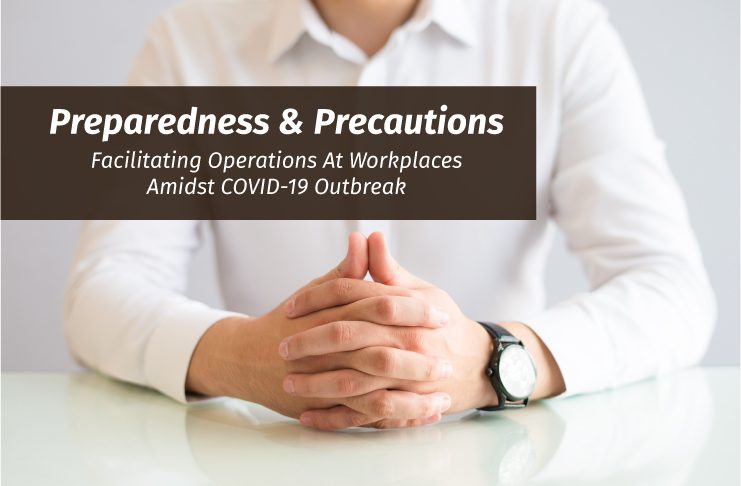Six months back and nobody had any idea of how the newly found species of Coronavirus could take such a bad turn. Its transition from epidemic to pandemic has severely affected more than 4.1 million people wide across the world and the numbers do not seem to stop. Today, everyone is faced with an unprecedented situation on which even expert alerts & advisories couldn’t give much clarity. All we can do to stop the spread or control of the pandemic is be circumspect at all times. From touching a surface to sitting next to a person, we must mind our actions.
Over the past few weeks, countries are put under strict lockdown trying to stop the spread of COVID-19 which has hit their economies hard. Millions of people are suffering from unemployment as the companies scramble to survive in such unpropitious times. The pressure on the government to revive it is intensifying from time to time. Therefore, it has become prudent to lift lockdown with a set of strict measures in which the economy drivers could operate without compromising with the health of their workers.
The organizations, regardless of their sizes, have been deliberating on the strategic actions to protect their employees from COVID-19 exposure. Some have gone ahead of the curve while some are still stuck with their workplace emergency preparedness plan. Helping organizations to prepare for resuming business operations amidst Coronavirus outbreak while keeping workers’ health & safety on top of their priority list, we have come up with the most important steps that can help curb the risks of COVID-19 exposure.
- Employee safety is a big responsibility for businesses, especially when coronavirus is still active and evolving rapidly. To shoulder it best, the companies must prepare an emergency preparedness and response plan which should have the following components.
- Where and how employees might be exposed to COVID-19. This will include the general public in public transportation or at public places, customers at the client sites, or in meeting rooms and co-workers in the cafeteria or conference rooms.
- Individual risk factors of each employee. This will include older age, other medical conditions, or exposure to a family member with COVID-19.
- Formation of Emergency Response Teams (ERT) within the organization for smooth implementation of the contingency plan if someone is found COVID-19 positive case.
- Set up of Isolation Rooms/Areas for employees showing COVID symptoms.
- Options for carrying out essential operations with a reduced workforce. This will include cross-training of employees across departments/levels, downsizing operations, and flexible work shifts.
- Measures to maintain social distancing in the workplace. This will include a rethink of office design such as cubicles, white glass partition of workstation, and seating at least six feet away from others on job sites and in gatherings, meetings, and training sessions.
Chart out an emergency preparedness and response plan
- Employee safety is a big responsibility for businesses, especially when coronavirus is still active and evolving rapidly. To shoulder it best, the companies must prepare an emergency preparedness and response plan which should have the following components.
- Where and how employees might be exposed to COVID-19. This will include the general public in public transportation or at public places, customers at the client sites, or in meeting rooms and co-workers in the cafeteria or conference rooms.
- Individual risk factors of each employee. This will include older age, other medical conditions, or exposure to a family member with COVID-19.
- Formation of Emergency Response Teams (ERT) within the organization for smooth implementation of the contingency plan if someone is found COVID-19 positive case.
- Set up of Isolation Rooms/Areas for employees showing COVID symptoms.
- Options for carrying out essential operations with a reduced workforce. This will include cross-training of employees across departments/levels, downsizing operations, and flexible work shifts.
- Measures to maintain social distancing in the workplace. This will include a rethink of office design such as cubicles, white glass partition of workstation, and seating at least six feet away from others on job sites and in gatherings, meetings, and training sessions.
Issue SOP for infection prevention & control:
Good hygiene and infection-control practices should be put in place at all offices, factories, and other establishments by employers as this is the most proactive countermeasure against the viral spread of COVID-19. The SOP must include:
- Frequent and thorough handwashing guidelines for workers, customers, and visitors along with the designated places/washrooms.
- Apt use of alcohol-based hand rubs containing at least 60% alcohol.
- How-to information on respiratory etiquettes such as covering coughs and sneezes.
- Space allocation guidelines for tissue boxes and trash receptacles.
- Strategies such as flexible worksites and staggered shifts to maintain and increase physical distancing among employees, between employees and others.
- Disallowance of using other workers’ telephones, desks, and other tools & equipment.
- Regular housekeeping practices, including routine cleaning & disinfecting of surfaces & equipment.
Communicate workplace policies & measures against COVID-19 with employees
As the employees will be dubious about their health and safety outside homes, it is important for the employers to establish trust. This trust of employees can only be achieved when they are well-aware of the best practices and policies a company has instituted in the interest of the employees. Therefore, the employers should aggressively work on their communication strategies, clear and subtle in nature that would act as a pull-factor for getting the employees back to work post lockdown.



